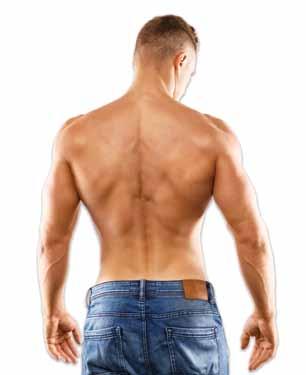
4 minute read
Surround Iconic Estate Health & Wellness
As we focus on and celebrate our trans friends and family, let’s also take a moment to celebrate their bodies. Many cisgendered people already have some degree of dysmorphic perspective about themselves, especially if they work out. But try to imagine what this might be like for a transgender person. Many are in the process of literally sculpting the body they want to call home, something that requires titanic will and bravery. I want to offer some observations and suggestions specifically to trans men, should they choose to hit the gym and build a classically masculine frame.
First — and this applies to any man — most guys focus far too much on chest and biceps. Yes, those are glamorous muscles, and having them is desirable. However, without the rest of the body being developed, there will be no appearance of proportion. With that in mind, I highly recommend training for balance, which itself will create the visual effect we call “sexy.”
Advertisement
The “ideal” physique is often called hourglass for women and v-taper or triangle for men. This means that people find male physiques most attractive when the shoulders and back are broad and the waist is small. To achieve this affect, you must do much more than chest and biceps.
You will want to immediately shift your focus to your shoulders and back. If you imagine your torso as a triangle, your shoulders are the two upper points, with the lines from them leading down to the single point that is your waist. For the visual impact to occur, you will want to aim for what is called The Golden Mean, also called The Golden Ratio.
The Golden Ratio has been important to human perception of beauty for thousands of years. This ratio is 1:1.618 (generally shortened to 1.6). This ratio occurs in plants, the arc of planetary trajectories, sea shells, and it goes on forever. People perceive it to be most attractive when the circumference of a man’s shoulders are 1.6 times the circumference of his waist. General hugeness is not what most people like. Better to be proportional in the way you can achieve naturally with as little help from steroids as possible. Understandably, I would normally advise people to avoid using hormones to magnify their results; however, for trans men, you should continue working closely with your doctors to ensure that your testosterone levels are where they need to be.
Understand that as you build your amazing upper body, you cannot neglect your core (or lower body — don’t skip leg day, bro). Having a thick waist with shoulders 1.6 times bigger will not achieve the Adonis effect. You will need to get your waist to its “proper” circumference. From there you aim to build the upper body.
What is the “ideal” waist circumference? For that you will want to consider the height-to-waist ratio. Whatever your height, your waist should be about 45 percent of that measurement. Getting as close to 1:1.447 as possible, you’ll be able to calculate your waist size.
Let’s do the math for a man who is exactly six feet tall: Height = 72 in (183 cm) Ideal waist = 45 percent of 72 in (183 cm) =
Building Your Ideal Male Physique Health & Wellness: How to Maximize Your Masculine Silhouette BY JACK KIRVEN | QNOTES CONTRIBuTOR
32.5 in (82.5 cm) Golden Mean for Shoulders = 1.6 x Ideal Waist = 1.618 x 32.5 (82.5 cm) = 52.5 in (134 cm)
So then, if you are six feet tall and want to achieve a classically ideal male physique, be sure to do shoulder, back, chest, biceps, triceps and cardiovascular training in such a way that you approach a ~32 inch waist and ~52 inch shoulder circumference. Measure your waist circumference at the level of your navel, and measure your shoulders at their widest point (usually around halfway between the tops of your shoulders and your nipple line). You will need someone to do these measurements for you. It is difficult to do your own waist properly, but nigh on impossible to properly wrap the measuring tape around the shoulders (let alone chest and back). This should be done on the skin, so do the measurements with someone in a place where you feel comfortable being shirtless.
A typical three-day body split will look something like this (often called The Bro Split, because it is the one most commonly used, especially amongst “gym bros”): Monday = Chest, Quads, and Triceps (aka Push), Wednesday = Back, Hamstrings, and Biceps (aka Pull), and Friday = Shoulders, Calves, and miscellaneous catch up for lagging parts that need to get zapped again. For example, if your upper chest isn’t keeping up despite your best effort on Monday, hit upper chest specifically on this miscellaneous day after you do shoulders. You can do core on each of these strength days, but doing core seven days per week is overkill. I suggest doing core and conditioning together on separate days from strength, so that you can give your all to each type of training. : :
Jack Kirven completed the MFA in Dance at UCLA, and earned certification as a personal trainer through NASM. His wellness philosophy is founded upon integrated lifestyles as opposed to isolated workouts. Visit him at jackkirven.com and INTEGRE8Twellness.com.
Photo Credit: blackday via Adobe Stock










